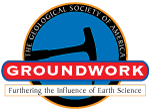Abstract View
Volume 27 Issue 11 (November 2017)
GSA Today
Article, pp. 4–5 | Full Text | PDF (275KB)
GROUNDWORK:
Classic Geologic Outcrops: Preservation and Future Accessibility
1 Dept. of Geology & Geophysics, University of Utah, Salt Lake City, Utah 84112, USA
2 Dept. of Geology, University of Kansas, Lawrence, Kansas 66045, USA
Introduction
Geologists are privileged to work in some of the most remarkable, beautiful, and remote areas on the Earth. As professionals, we must care for important outcrops so they can continue to enlighten and educate earth scientists well into the future. Rock archives of valuable information, and access to these outcrops, can be destroyed by a few thoughtless actions. Accessible, exemplary geologic sites are visited by numerous individuals and field-trip groups each year. The consequences of unauthorized access, and the impact of rock hammers, painted section numbers, drill plug holes, and other evidence of increasing visits to these classic sites has serious consequences. In order to protect continued access for students and researchers, we, as a geologic community, must act responsibly by getting proper permits where required, conserving and protecting classic localities, and respecting land-use rules. In the following, we discuss a few examples of the preservation and accessibility of classic outcrops we have studied for years, recognizing that similar issues are prevalent globally.
Manuscript received 16 Apr. 2017; Revised manuscript received 15 June 2017; Manuscript accepted 21 June 2017; Posted online 3 Aug. 2017
10.1130/GSATG343GW.1
©2017, The Geological Society of America.

